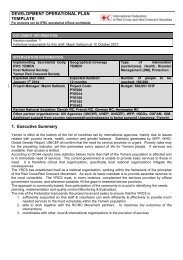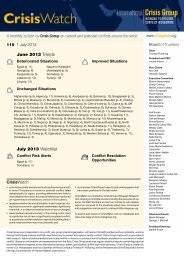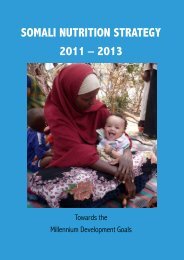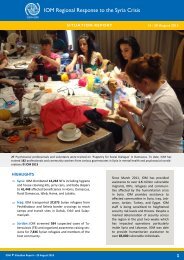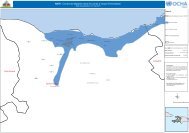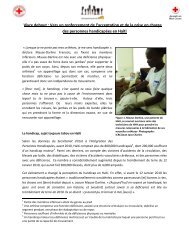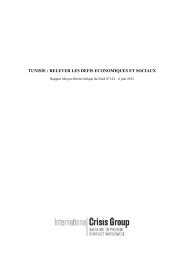issues for consideration at the berlin donor conference ... - ReliefWeb
issues for consideration at the berlin donor conference ... - ReliefWeb
issues for consideration at the berlin donor conference ... - ReliefWeb
You also want an ePaper? Increase the reach of your titles
YUMPU automatically turns print PDFs into web optimized ePapers that Google loves.
6 THE ROAD AHEAD<br />
Educ<strong>at</strong>ion aims “to provide opportunities <strong>for</strong> secondary and higher educ<strong>at</strong>ion of intern<strong>at</strong>ional<br />
standard to build human resources which are able to meet priv<strong>at</strong>e-sector driven n<strong>at</strong>ional<br />
development, social and reconstruction objectives.” 28<br />
To achieve such lofty goals, huge strides must be made in educ<strong>at</strong>ion levels and school enrollment.<br />
• Afghanistan has <strong>the</strong> lowest literacy r<strong>at</strong>e in Asia, an estim<strong>at</strong>ed 36 percent (51 percent male, 21<br />
percent female). 29 UNICEF estim<strong>at</strong>es th<strong>at</strong> <strong>the</strong> current female literacy r<strong>at</strong>e is actually closer<br />
to 10 percent. 30<br />
• The current girls’ enrollment as a percentage of total children enrolled in primary school is<br />
roughly 40 percent, as compared to 3 percent in 1999 under Taliban rule, and 35 percent in<br />
1995, be<strong>for</strong>e <strong>the</strong> Taliban takeover. 31 Yet <strong>the</strong> overall percentage of girls <strong>at</strong>tending primary<br />
school is misleading; in <strong>the</strong> more religiously conserv<strong>at</strong>ive sou<strong>the</strong>rn and eastern regions of<br />
Afghanistan, girls’ enrollment is far lower than elsewhere in <strong>the</strong> country.<br />
Girls’ Enrollment (2003)<br />
Primary School Middle School High School University<br />
1,300,000 68,000 31,000 5,800<br />
Source: “Securing Afghanistan’s Future: Accomplishments and <strong>the</strong> Way Forward. Educ<strong>at</strong>ion: Technical Annex,” January 2004.<br />
• According to UNICEF, <strong>the</strong> educ<strong>at</strong>ion sector is functioning in all of Afghanistan’s 32<br />
provinces and 329 districts. 32<br />
o In 2002, <strong>the</strong> Afghan government and its partners in <strong>the</strong> educ<strong>at</strong>ion sector expected<br />
1.7 million students to enroll. Instead, more than three million students were<br />
enrolled in grades 1-12 th<strong>at</strong> year.<br />
o In March 2003, enrollment rose to four million. Of those, 90 percent are in primary<br />
school, and about 60 percent are in grades one and two alone. 33<br />
• Enrollment and interest in higher educ<strong>at</strong>ion has increased since <strong>the</strong> fall of <strong>the</strong> Taliban,<br />
during which time curriculum was concentr<strong>at</strong>ed on Islamic Studies. 34<br />
o In 2003, 31,000 students enrolled in Afghanistan’s 17 higher educ<strong>at</strong>ion institutions,<br />
up from 4,000 in 2001. Nearly 70 percent of <strong>the</strong> students are in <strong>the</strong> first two years<br />
of study. 35<br />
o The Ministry of Higher Educ<strong>at</strong>ion aims to increase <strong>the</strong> number of higher educ<strong>at</strong>ion<br />
students to 100,000 by 2015. With a 20-year-old curriculum and just over half of<br />
28 Ibid.<br />
29 UNICEF, “Afghanistan: At a Glance St<strong>at</strong>istics,” <br />
(accessed December 14, 2003). Figures cited represent <strong>the</strong> 2000 estim<strong>at</strong>ed literacy r<strong>at</strong>e.<br />
30 UNICEF, “Draft: UNICEF Girls Educ<strong>at</strong>ion Program (GEP) Afghanistan 2003-2004,” November 26, 2003.<br />
31 “A New Start <strong>for</strong> Afghanistan’s Educ<strong>at</strong>ion Sector,” Asian Development Bank report, April 2003,<br />
<br />
(accessed November 5, 2003).<br />
32 UNICEF, “Rebuilding Hope in Afghanistan,” November 2003,<br />
(accessed December 5, 2003).<br />
33 Educ<strong>at</strong>ion Technical Annex. This demographic bubble is due to <strong>the</strong> interruption in schooling during <strong>the</strong> Taliban, and<br />
will migr<strong>at</strong>e through <strong>the</strong> school system as children m<strong>at</strong>ricul<strong>at</strong>e.<br />
34 “A New Start <strong>for</strong> Afghanistan’s Educ<strong>at</strong>ion Sector,” April 2003, Asian Development Bank report,<br />
<br />
(accessed November 5, 2003) [hereinafter “Asian Development Bank report”].<br />
35 Educ<strong>at</strong>ion Technical Annex.




